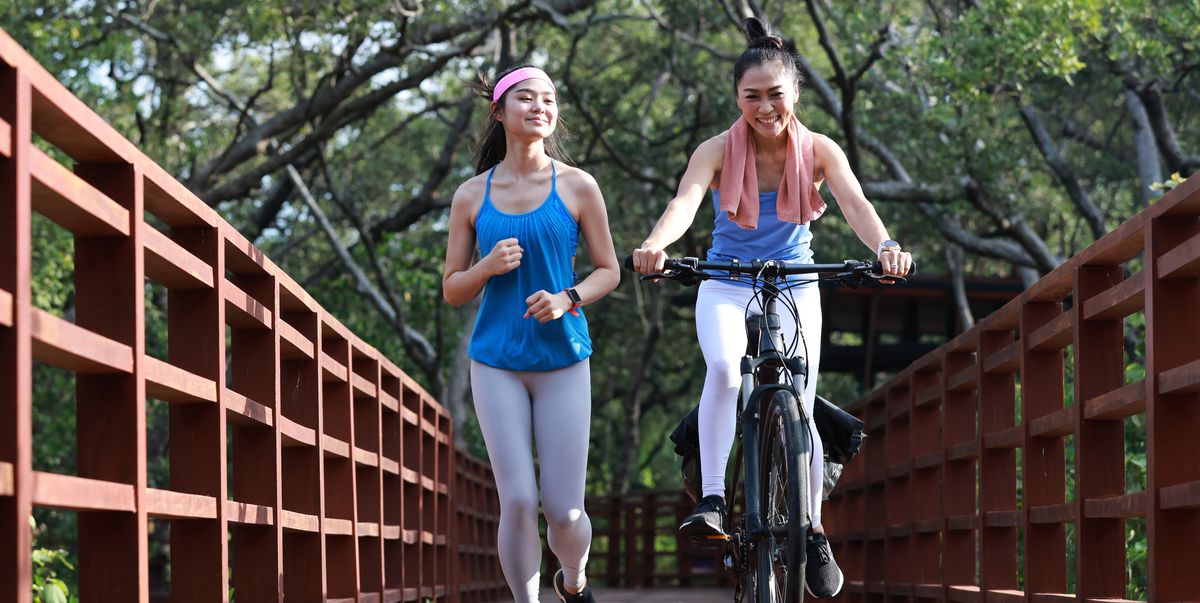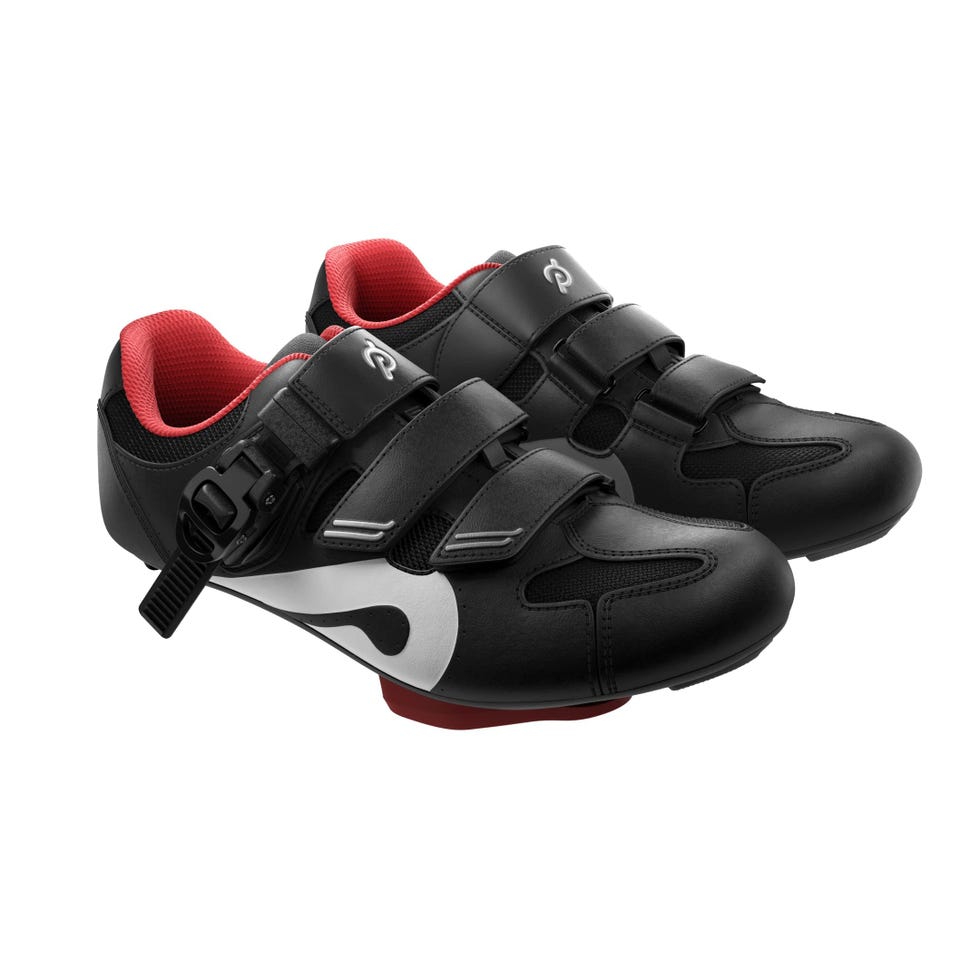Both runners and cyclists can be die-hard about their sports. You might have a friend who is always busy with their Sunday long run and another who never misses their favorite cycling class. If you want to add more cardio to your fitness routine but you’re not sure which modality is better, you can rest assured knowing both have excellent benefits.
“Running is a great option to support your cardio health because it’s very convenient—the only equipment you need is a pair of shoes,” says ACE-certified personal trainer Sydney Smith, CPT. “On the flip side, cycling is a low-impact exercise, making it gentler by nature on your joints.”
Meet the experts: Sydney Smith, CPT, ACE-certified personal trainer at Ideal Physiques in Phoenix, Arizona. Cynthia Barrett, DPT, CSCS, is a doctor of physical therapy, certified strength and conditioning specialist, and the founder and CEO of Wellness Couture NYC. Olivia Amato, CPT, is a bike, tread, boot camp, and strength instructor for Peloton based in New York City.
Of course, in order to reap the benefits of cycling and/or running—be it building strength, improving cardiovascular health, or losing weight—you’ll need to pick the activity that you can stay consistent with. That’s the surefire way you’ll reach your fitness goals, says doctor of physical therapy and certified strength and conditioning specialist Cynthia Barrett, DPT, CSCS.
Read on for which modality trainers say best supports strength, weight loss, and cardio health. (Hint: You can’t really go wrong!)
Cycling Vs. Running For Strength
Trainer verdict: Cycling
If your primary goals lie around building strength, cycling is superior. On the bike, you can adjust the resistance of the gears and ride in a way that targets specific muscle groups, Barrett explains. Adjusting resistance—such as by using a higher gear or engaging in high-intensity cycling intervals like hill sprints—mimics resistance training by continuously loading major leg muscles such as the quadriceps, hamstrings, glutes, and calves, leading to more effective muscle development than running. (FYI: If you just spin your wheels on flat road all the time, without adding challenge and progressively loading your muscles, you may not build strength to the same degree as applying resistance or intervals.)
Barrett says cycling will help:
- Strengthen your core as you pedal, as you work to stay stable on the bike
- Build your calves with each pedal stroke
- Work your quads and glutes when you stand up out of the saddle as you increase resistance or climb up a hill
- Target the hamstrings when you’re doing seated sprints
Cycling has been shown to build muscle due to the way it forces your muscles to adapt as you change resistance, according to a 2021 study in the Journal of Experimental Biology. Plus, since it builds strength in a low-impact way, it’s great for beginners and those who might be returning to exercise after an injury, says trainer Olivia Amato, CPT.
However, if you opt for running, you won’t totally lose out on strength-building—you just have to be strategic by incorporating short sprints or incline or hill work into your training, Barrett adds. (More on that later!)
Cycling Vs. Running For Weight Loss
Trainer verdict: Running
When it comes to weight loss, our experts agree: running tends to be the better cardio workout, due to the high calorie burn you get. In simple terms, weight loss occurs when you burn more calories than you consume (calorie deficit) and a high-intensity cardio workout helps you achieve that.
“At the higher intensity you’ll be able to tap into on runs, you’ll see more weight-loss benefits because you’re using and recruiting more muscles in your body” compared to cycling, Barrett says. Your leg muscles are (obviously) working to keep you moving, your core is engaged to keep your posture upright, and your arms are pumping to engage the shoulders and back.
This high-impact exercise, especially when done at high-intensity intervals or a comfortably hard pace, delivers a full-body workout—and burns a significant amount of calories, boosts fat metabolism, and triggers the continued calorie burn post-workout, Barret says. Running leads to more calorie burn than cycling: A 130-pound person running a 10-minute mile (six miles per hour) generally burns 589 calories an hour, while indoor cycling at 5.5 miles per hour usually burns 235 calories an hour, based on estimates by the American Council on Exercise’s physical activity calorie counter.
Research also proves that running is better for weight loss: A small 2019 study in the International Journal of Research in Exercise Physiology found that, in a small group of men with obesity, running on a treadmill burned more calories than cycling on an upright, Airdyne, or recumbent bike.
However, if you need to avoid high-impact activities like running due to an injury, riding still provides a great cardio substitute.
Cycling Vs. Running For Cardiovascular Health
Trainer verdict: Running
There are a slew of benefits that also put running on top when it comes to cardiovascular health. A 2024 meta-analysis in Sports Medicine Open with 2.6 million participants found running reduces the risk of cardiovascular events and can help improve both resting heart rate and overall cardio fitness. (When your resting heart rate is lower, your heart is more efficient at pumping your blood throughout your body, Barrett says.)
Additionally, “running is great because you’re really tapping into your VO2 max,” says Barrett. This is a fancy way to talk about the amount of oxygen your body can use during intense exercise; the higher your VO2 max, the more efficient your body is at using oxygen. This essentially translates to better aerobic fitness, making your workouts feel easier and enabling you to do more challenging workouts. For runners, this could mean it’s easy for you to talk with your training partner while you’re logging miles, Barrett adds.
Running is a cardio-based plyometric exercise that can boost your muscular endurance, Smith says. Better muscular endurance allows you to work longer without getting fatigued (think feeling stronger on your long run), which in turn will help support your heart health.
As cycling is a lower-impact workout and doesn’t use as many muscles, it won’t be as effective for improving overall VO2 max. But it can still be a great alternative for those who want to add more cardio into their routine—especially for those with joint issues or injury considerations, as well as middle-age and older adults, Barrett says.
Whether you’re running or cycling, the more you train, the stronger your heart muscle will get, which can help lower blood pressure and risk of type 2 diabetes, and increase good cholesterol, according to the National Heart, Lung, and Blood Institute.
Running Vs. Cycling For Your Goals
Whether running or cycling is better for you comes down to your personal preference and fitness goals. Both cardio modalities will provide a great workout, but cycling is the standout for building muscle, while running can better support weight loss and cardiovascular health.
If your goal is building endurance:
Running and cycling are both excellent when it comes to improving your endurance, so pick whichever one you prefer. Run or cycle three to five days per week, starting with fewer days if you’re a beginner, then adding in more.
For cyclists, Barrett suggests riding for 30 to 35 minutes at first, then building up to 45 or 60 minutes on the bike. Your heart rate should typically be at about 60 to 75 percent of your maximum (220 – your age).
Runners should run for 20 to 40 minutes at a time at a conversational pace, says Barrett. To push endurance, you can also add one to two tempo runs per week, which will help you increase your speed over time and become a more efficient runner, Smith says.
If your goal is improving strength:
Since cycling is better for building strength, you’ll want to hop on a bike three to four days per week. Take cycling classes that are 45 to 60 minutes long and play with the resistance, or ride outdoors for 45 to 75 minutes at a time, incorporating hill work. When cycling, make sure your heart rate is mostly at 60 to 75 percent of your max heart rate. (If you prefer running, you’ll want to increase your frequency, lacing up three to five days per week for about 30 to 60 minutes at a conversational pace. Mix up your routine with track workouts or incline or hill work.)
To improve strength, it’s also integral to strength train at least two days a week and hit large muscle groups, like lunging and squatting during leg days. Do four to six exercises per workout, completing three sets of 6 to 8 reps, and lift to failure, which is when you can’t do another rep with good form, to maximize muscle growth, Smith says.
If your goal is losing weight:
When it comes to weight loss, consistency is key, so choose the workout that you’re more likely to stick with, Smith says. However, if you don’t have a preference, Barrett recommends running three to four days per week for 20 to 30 minutes with an intensity component to your runs, such as a tempo run, where your pace feels challenging and it would be difficult to hold a conversation, Barrett says. (If you want to cycle instead, bike for 30 to 60 minutes three to four days per week, making sure each ride is moderate intensity—between 50 and 70 percent of your max heart rate. Intermediate cyclists can bump up to four to six days per week.)
Combining either running or cycling with two to three days of strength training will help accelerate fat loss and prevent injuries, Barrett adds.
All in all, cycling and running offer similar cardiovascular and calorie-burning benefits, so choose the workout that suits your interests and lifestyle, and feels fun for you. If you try running and just can’t find your footing (figuratively, of course), see how you feel about cycling. If you just can’t find your groove on two wheels, take up running. Either way, you’ll get a great cardio workout.

Jordan Smith is a freelance writer, editor, and author with 10 years of experience reporting on health and fitness news and trends. She’s also an ISSA certified running coach, and is passionate about making fitness accessible to all. You can find her work in publications including Runner’s World, SELF, Prose, Vital Proteins, and more. The Philadelphia-based writer has yet to meet a workout class she doesn’t like and can be found exploring the robust Philly food scene, hiking with her three dogs, and chronicling her attempt at tackling her .
Read the full article here





